Value Management Report: Situational Analysis of Sunway Construction
VerifiedAdded on 2020/02/24
|41
|10011
|74
Report
AI Summary
This report provides a detailed analysis of value management strategies applied to Sunway Construction. It begins with an introduction to value management and an overview of Sunway Group, followed by a situational analysis using the 5C's framework and an examination of the five phases of value management techniques. The report then proposes feasible changes, including value measurement solutions and periodic milestones, along with the benefits of these changes, such as value proposition and monetary gains. It also discusses the implications of not adopting the proposed solutions for both the company and its stakeholders. Furthermore, the report includes an evidence review with a conceptual model, critique, and future research perspectives. Finally, it concludes with a reflection on employability enhancement and leadership, evaluating current status, identifying gaps, and outlining future personal development plans. The report emphasizes critical thinking and core capabilities required for consultancy tasks and offers actionable insights for improving value management within the construction industry.

Running head: VALUE MANAGEMENT
Value Management
Student’s name:
Name of the university:
Author’s note:
Value Management
Student’s name:
Name of the university:
Author’s note:
Paraphrase This Document
Need a fresh take? Get an instant paraphrase of this document with our AI Paraphraser
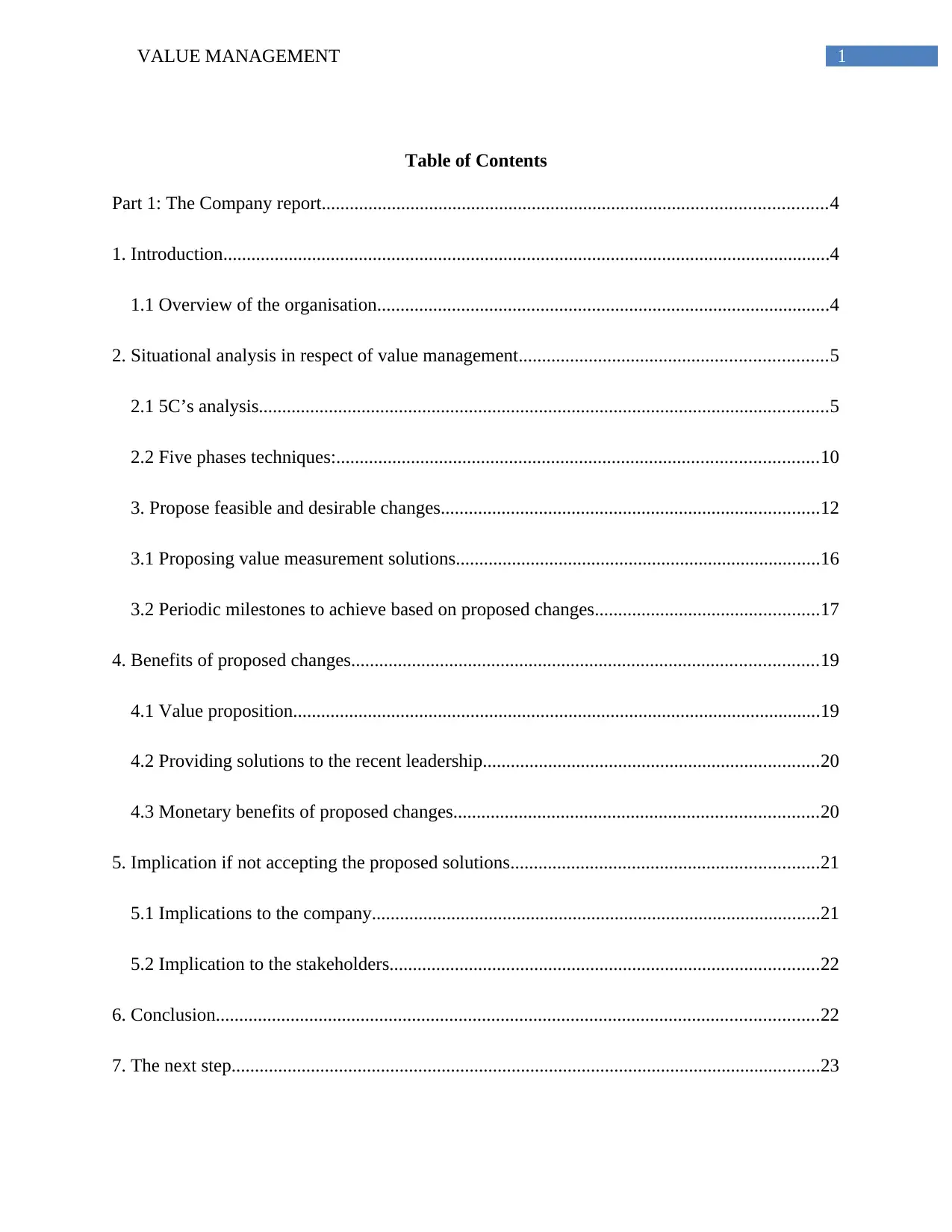
1VALUE MANAGEMENT
Table of Contents
Part 1: The Company report............................................................................................................4
1. Introduction..................................................................................................................................4
1.1 Overview of the organisation.................................................................................................4
2. Situational analysis in respect of value management..................................................................5
2.1 5C’s analysis..........................................................................................................................5
2.2 Five phases techniques:.......................................................................................................10
3. Propose feasible and desirable changes.................................................................................12
3.1 Proposing value measurement solutions..............................................................................16
3.2 Periodic milestones to achieve based on proposed changes................................................17
4. Benefits of proposed changes....................................................................................................19
4.1 Value proposition.................................................................................................................19
4.2 Providing solutions to the recent leadership........................................................................20
4.3 Monetary benefits of proposed changes..............................................................................20
5. Implication if not accepting the proposed solutions..................................................................21
5.1 Implications to the company................................................................................................21
5.2 Implication to the stakeholders............................................................................................22
6. Conclusion.................................................................................................................................22
7. The next step..............................................................................................................................23
Table of Contents
Part 1: The Company report............................................................................................................4
1. Introduction..................................................................................................................................4
1.1 Overview of the organisation.................................................................................................4
2. Situational analysis in respect of value management..................................................................5
2.1 5C’s analysis..........................................................................................................................5
2.2 Five phases techniques:.......................................................................................................10
3. Propose feasible and desirable changes.................................................................................12
3.1 Proposing value measurement solutions..............................................................................16
3.2 Periodic milestones to achieve based on proposed changes................................................17
4. Benefits of proposed changes....................................................................................................19
4.1 Value proposition.................................................................................................................19
4.2 Providing solutions to the recent leadership........................................................................20
4.3 Monetary benefits of proposed changes..............................................................................20
5. Implication if not accepting the proposed solutions..................................................................21
5.1 Implications to the company................................................................................................21
5.2 Implication to the stakeholders............................................................................................22
6. Conclusion.................................................................................................................................22
7. The next step..............................................................................................................................23
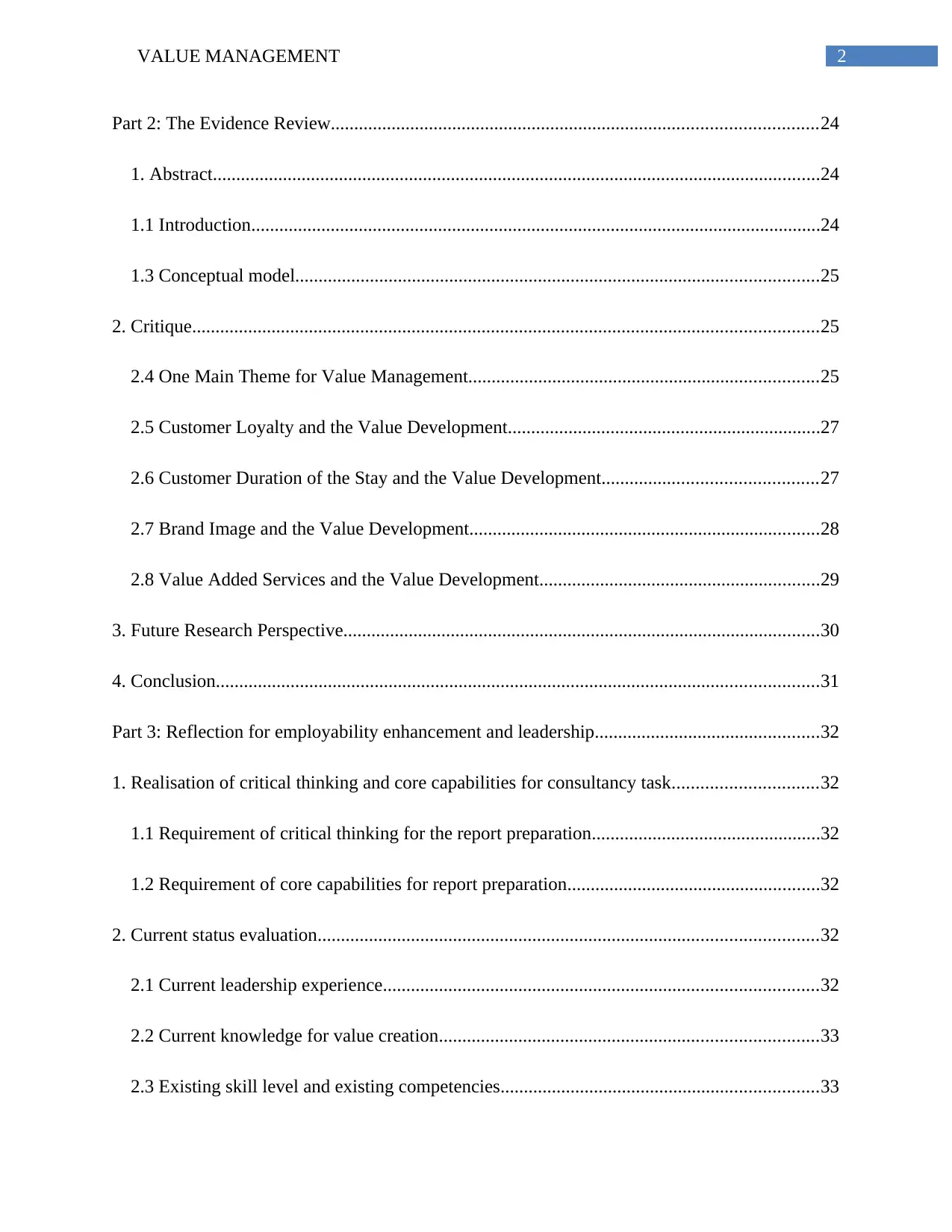
2VALUE MANAGEMENT
Part 2: The Evidence Review........................................................................................................24
1. Abstract..................................................................................................................................24
1.1 Introduction..........................................................................................................................24
1.3 Conceptual model................................................................................................................25
2. Critique......................................................................................................................................25
2.4 One Main Theme for Value Management...........................................................................25
2.5 Customer Loyalty and the Value Development...................................................................27
2.6 Customer Duration of the Stay and the Value Development..............................................27
2.7 Brand Image and the Value Development...........................................................................28
2.8 Value Added Services and the Value Development............................................................29
3. Future Research Perspective......................................................................................................30
4. Conclusion.................................................................................................................................31
Part 3: Reflection for employability enhancement and leadership................................................32
1. Realisation of critical thinking and core capabilities for consultancy task...............................32
1.1 Requirement of critical thinking for the report preparation.................................................32
1.2 Requirement of core capabilities for report preparation......................................................32
2. Current status evaluation...........................................................................................................32
2.1 Current leadership experience.............................................................................................32
2.2 Current knowledge for value creation.................................................................................33
2.3 Existing skill level and existing competencies....................................................................33
Part 2: The Evidence Review........................................................................................................24
1. Abstract..................................................................................................................................24
1.1 Introduction..........................................................................................................................24
1.3 Conceptual model................................................................................................................25
2. Critique......................................................................................................................................25
2.4 One Main Theme for Value Management...........................................................................25
2.5 Customer Loyalty and the Value Development...................................................................27
2.6 Customer Duration of the Stay and the Value Development..............................................27
2.7 Brand Image and the Value Development...........................................................................28
2.8 Value Added Services and the Value Development............................................................29
3. Future Research Perspective......................................................................................................30
4. Conclusion.................................................................................................................................31
Part 3: Reflection for employability enhancement and leadership................................................32
1. Realisation of critical thinking and core capabilities for consultancy task...............................32
1.1 Requirement of critical thinking for the report preparation.................................................32
1.2 Requirement of core capabilities for report preparation......................................................32
2. Current status evaluation...........................................................................................................32
2.1 Current leadership experience.............................................................................................32
2.2 Current knowledge for value creation.................................................................................33
2.3 Existing skill level and existing competencies....................................................................33
⊘ This is a preview!⊘
Do you want full access?
Subscribe today to unlock all pages.

Trusted by 1+ million students worldwide

3VALUE MANAGEMENT
2.4 Gap analysis.........................................................................................................................33
2.5 Challenges experienced.......................................................................................................34
2.6 Overcoming the gap.............................................................................................................34
2.6 New knowledge acquired....................................................................................................35
2.7 Emergent conclusion...........................................................................................................35
3. Future Personal Development....................................................................................................35
Reference List................................................................................................................................36
2.4 Gap analysis.........................................................................................................................33
2.5 Challenges experienced.......................................................................................................34
2.6 Overcoming the gap.............................................................................................................34
2.6 New knowledge acquired....................................................................................................35
2.7 Emergent conclusion...........................................................................................................35
3. Future Personal Development....................................................................................................35
Reference List................................................................................................................................36
Paraphrase This Document
Need a fresh take? Get an instant paraphrase of this document with our AI Paraphraser

4VALUE MANAGEMENT
Part 1: The Company report
1. Introduction
Value management is an important planning and critical review process that is different
from the concept of work plan, moreover, it focuses to achieve better value with the idea of value
for money concept. Most of the organisations are following value management technique as it
helps to deliver the better-valued results to customers. In historical innovation, value
management came from idea of ‘value analyses' in the subject of General Electric. With the
advancement of time, the concept of Value Engineering came in the USA that helped to use
shared resources in right manner. In this part, Sunway Construction organisation has been chosen
for this report. In first part, the existing value management strategies will be stated and current
inadequacy will be highlighted. Moreover, in the following part, new and feasible changes will
be proposed with value measurement solutions. New strategies and operations with development
results will be discussed with benefits. In last section of the study, potential risks that the
organisation might face if they do not follow proposed solutions will be stated.
1.1 Overview of the organisation
Sunway Group was established in the year 1974 and this organisation has been working
in the field of construction of building, property construction in healthcare and education. This
organisation is operating in more than 51 locations worldwide with 15,000 team capacities.
Sunway Group is focusing mainly on developing sustainable communities with planning on real
estate investment. Sunway Group has been making the Sunway cities in various places over
Malaysia in places like Ipoh, Selangor and Johar. The organisation has commitment to
Part 1: The Company report
1. Introduction
Value management is an important planning and critical review process that is different
from the concept of work plan, moreover, it focuses to achieve better value with the idea of value
for money concept. Most of the organisations are following value management technique as it
helps to deliver the better-valued results to customers. In historical innovation, value
management came from idea of ‘value analyses' in the subject of General Electric. With the
advancement of time, the concept of Value Engineering came in the USA that helped to use
shared resources in right manner. In this part, Sunway Construction organisation has been chosen
for this report. In first part, the existing value management strategies will be stated and current
inadequacy will be highlighted. Moreover, in the following part, new and feasible changes will
be proposed with value measurement solutions. New strategies and operations with development
results will be discussed with benefits. In last section of the study, potential risks that the
organisation might face if they do not follow proposed solutions will be stated.
1.1 Overview of the organisation
Sunway Group was established in the year 1974 and this organisation has been working
in the field of construction of building, property construction in healthcare and education. This
organisation is operating in more than 51 locations worldwide with 15,000 team capacities.
Sunway Group is focusing mainly on developing sustainable communities with planning on real
estate investment. Sunway Group has been making the Sunway cities in various places over
Malaysia in places like Ipoh, Selangor and Johar. The organisation has commitment to

5VALUE MANAGEMENT
developing strong social, economic and environmental practices in day-to-day operations.
Sunway Group believes in the business in the Build-Own-Operate business model and the
organisation is trying to create value chain operation to make the win-win situation for all the
stakeholders (Sunway.com, 2017). Apart from Malaysia, this organisation has its presence in
China, Abu Dhabi, Singapore, Indonesia and many other places in construction of buildings.
2. Situational analysis in respect of value management
In understanding the condition of an organisation in industry, conducting situational
analysis is helpful. Sunway Group is working in the construction and real estate field and the
value management strategies and current status of values.
2.1 5C’s analysis
Company: Sunway Group organisation has its objectives to innovate and deliver the best
values to the customers. The aim of the organisation is to provide sustainable changes that can
produce value to the stakeholders. In addition, the organisation is trying to build sustainable
relationships that can synergy to the external parties and customers. Sunway Group organisation
is focusing to achieve the highest quality that can excel the competitors in market.
Competitors: Sunway Group has many competitors in the Malaysian market and the
organisation has to analyse the potential capabilities and nature of business competitors in order
to have the clear picture (Walker 2015). The big competitors in the market of Malaysia for
Sunway Group are Conlay construction, Fluor Daniel International, AME construction and
others.
Customers: In the Malaysian market, Sunway Group has the customers mainly of
community people who want to have better community living. More than that, the organisation
developing strong social, economic and environmental practices in day-to-day operations.
Sunway Group believes in the business in the Build-Own-Operate business model and the
organisation is trying to create value chain operation to make the win-win situation for all the
stakeholders (Sunway.com, 2017). Apart from Malaysia, this organisation has its presence in
China, Abu Dhabi, Singapore, Indonesia and many other places in construction of buildings.
2. Situational analysis in respect of value management
In understanding the condition of an organisation in industry, conducting situational
analysis is helpful. Sunway Group is working in the construction and real estate field and the
value management strategies and current status of values.
2.1 5C’s analysis
Company: Sunway Group organisation has its objectives to innovate and deliver the best
values to the customers. The aim of the organisation is to provide sustainable changes that can
produce value to the stakeholders. In addition, the organisation is trying to build sustainable
relationships that can synergy to the external parties and customers. Sunway Group organisation
is focusing to achieve the highest quality that can excel the competitors in market.
Competitors: Sunway Group has many competitors in the Malaysian market and the
organisation has to analyse the potential capabilities and nature of business competitors in order
to have the clear picture (Walker 2015). The big competitors in the market of Malaysia for
Sunway Group are Conlay construction, Fluor Daniel International, AME construction and
others.
Customers: In the Malaysian market, Sunway Group has the customers mainly of
community people who want to have better community living. More than that, the organisation
⊘ This is a preview!⊘
Do you want full access?
Subscribe today to unlock all pages.

Trusted by 1+ million students worldwide
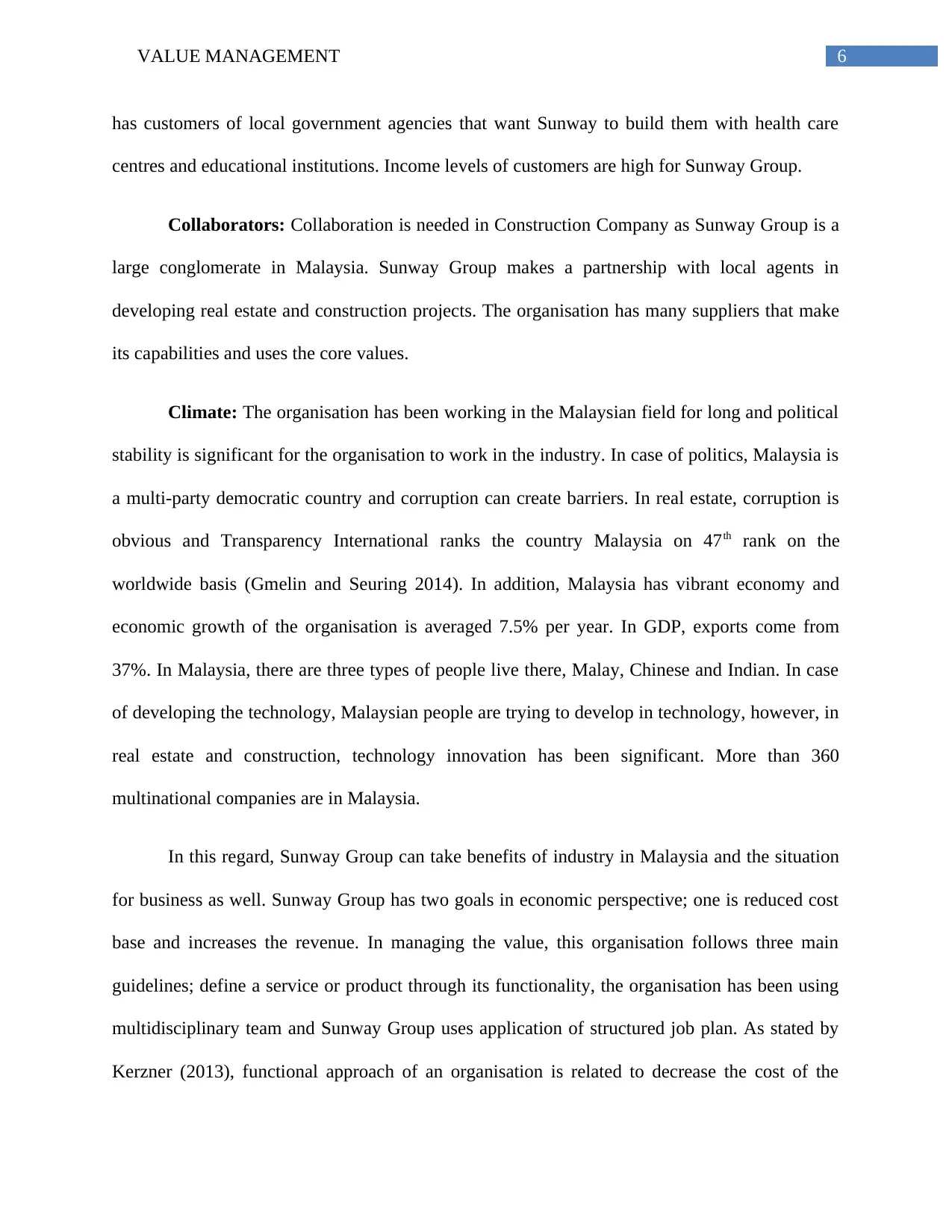
6VALUE MANAGEMENT
has customers of local government agencies that want Sunway to build them with health care
centres and educational institutions. Income levels of customers are high for Sunway Group.
Collaborators: Collaboration is needed in Construction Company as Sunway Group is a
large conglomerate in Malaysia. Sunway Group makes a partnership with local agents in
developing real estate and construction projects. The organisation has many suppliers that make
its capabilities and uses the core values.
Climate: The organisation has been working in the Malaysian field for long and political
stability is significant for the organisation to work in the industry. In case of politics, Malaysia is
a multi-party democratic country and corruption can create barriers. In real estate, corruption is
obvious and Transparency International ranks the country Malaysia on 47th rank on the
worldwide basis (Gmelin and Seuring 2014). In addition, Malaysia has vibrant economy and
economic growth of the organisation is averaged 7.5% per year. In GDP, exports come from
37%. In Malaysia, there are three types of people live there, Malay, Chinese and Indian. In case
of developing the technology, Malaysian people are trying to develop in technology, however, in
real estate and construction, technology innovation has been significant. More than 360
multinational companies are in Malaysia.
In this regard, Sunway Group can take benefits of industry in Malaysia and the situation
for business as well. Sunway Group has two goals in economic perspective; one is reduced cost
base and increases the revenue. In managing the value, this organisation follows three main
guidelines; define a service or product through its functionality, the organisation has been using
multidisciplinary team and Sunway Group uses application of structured job plan. As stated by
Kerzner (2013), functional approach of an organisation is related to decrease the cost of the
has customers of local government agencies that want Sunway to build them with health care
centres and educational institutions. Income levels of customers are high for Sunway Group.
Collaborators: Collaboration is needed in Construction Company as Sunway Group is a
large conglomerate in Malaysia. Sunway Group makes a partnership with local agents in
developing real estate and construction projects. The organisation has many suppliers that make
its capabilities and uses the core values.
Climate: The organisation has been working in the Malaysian field for long and political
stability is significant for the organisation to work in the industry. In case of politics, Malaysia is
a multi-party democratic country and corruption can create barriers. In real estate, corruption is
obvious and Transparency International ranks the country Malaysia on 47th rank on the
worldwide basis (Gmelin and Seuring 2014). In addition, Malaysia has vibrant economy and
economic growth of the organisation is averaged 7.5% per year. In GDP, exports come from
37%. In Malaysia, there are three types of people live there, Malay, Chinese and Indian. In case
of developing the technology, Malaysian people are trying to develop in technology, however, in
real estate and construction, technology innovation has been significant. More than 360
multinational companies are in Malaysia.
In this regard, Sunway Group can take benefits of industry in Malaysia and the situation
for business as well. Sunway Group has two goals in economic perspective; one is reduced cost
base and increases the revenue. In managing the value, this organisation follows three main
guidelines; define a service or product through its functionality, the organisation has been using
multidisciplinary team and Sunway Group uses application of structured job plan. As stated by
Kerzner (2013), functional approach of an organisation is related to decrease the cost of the
Paraphrase This Document
Need a fresh take? Get an instant paraphrase of this document with our AI Paraphraser

7VALUE MANAGEMENT
organisation and it can evaluate the value of product. The purpose of value analysis is to describe
the cost necessary to gain the required function. Satisfaction of stakeholders is necessary for
producing values and in construction companies believe in ‘expansive' management of value.
For the last few years, practitioners and management of Sunway Group have been using
the value management that formulates the strategies with executing value management. A
business portfolio is all about setting new capabilities for an organisation that can enable the
organisation in competing in the market (Holzbaur et al. 2016). Sunway Organisation is in real
estate and construction project and this organisation believe in three core values, Humility,
Integrity and Excellence (Sunway.com 2017). It is observed that value management is necessary
for an organisation in construction project to operate in contractual relationship and integration
of various supply chain. In this regard, it is observed that contractual language is needed to be
simple and organisation should provide best value option. Sunway Group does not aim to
achieve value for the resources they have, however, a correct methodology can help the
organisation in delivering the best project through better communication, through team working
and developed supply chain. In each project of Sunway Group is related to the risk matrix and it
can be identified with value management. As opined by Emerson (2013), value management can
be described as team-based techniques that can provide surety in giving best value to the clients.
organisation and it can evaluate the value of product. The purpose of value analysis is to describe
the cost necessary to gain the required function. Satisfaction of stakeholders is necessary for
producing values and in construction companies believe in ‘expansive' management of value.
For the last few years, practitioners and management of Sunway Group have been using
the value management that formulates the strategies with executing value management. A
business portfolio is all about setting new capabilities for an organisation that can enable the
organisation in competing in the market (Holzbaur et al. 2016). Sunway Organisation is in real
estate and construction project and this organisation believe in three core values, Humility,
Integrity and Excellence (Sunway.com 2017). It is observed that value management is necessary
for an organisation in construction project to operate in contractual relationship and integration
of various supply chain. In this regard, it is observed that contractual language is needed to be
simple and organisation should provide best value option. Sunway Group does not aim to
achieve value for the resources they have, however, a correct methodology can help the
organisation in delivering the best project through better communication, through team working
and developed supply chain. In each project of Sunway Group is related to the risk matrix and it
can be identified with value management. As opined by Emerson (2013), value management can
be described as team-based techniques that can provide surety in giving best value to the clients.
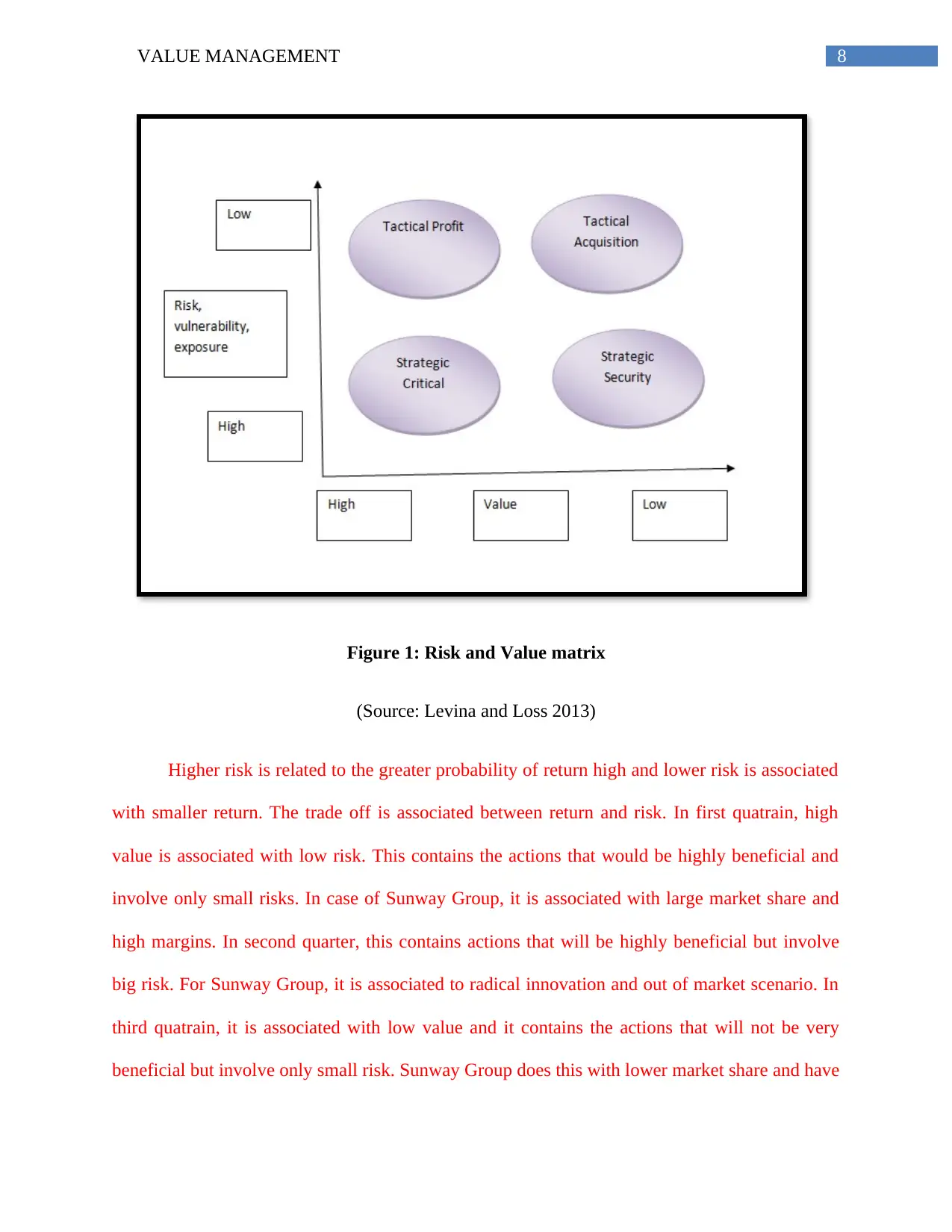
8VALUE MANAGEMENT
Figure 1: Risk and Value matrix
(Source: Levina and Loss 2013)
Higher risk is related to the greater probability of return high and lower risk is associated
with smaller return. The trade off is associated between return and risk. In first quatrain, high
value is associated with low risk. This contains the actions that would be highly beneficial and
involve only small risks. In case of Sunway Group, it is associated with large market share and
high margins. In second quarter, this contains actions that will be highly beneficial but involve
big risk. For Sunway Group, it is associated to radical innovation and out of market scenario. In
third quatrain, it is associated with low value and it contains the actions that will not be very
beneficial but involve only small risk. Sunway Group does this with lower market share and have
Figure 1: Risk and Value matrix
(Source: Levina and Loss 2013)
Higher risk is related to the greater probability of return high and lower risk is associated
with smaller return. The trade off is associated between return and risk. In first quatrain, high
value is associated with low risk. This contains the actions that would be highly beneficial and
involve only small risks. In case of Sunway Group, it is associated with large market share and
high margins. In second quarter, this contains actions that will be highly beneficial but involve
big risk. For Sunway Group, it is associated to radical innovation and out of market scenario. In
third quatrain, it is associated with low value and it contains the actions that will not be very
beneficial but involve only small risk. Sunway Group does this with lower market share and have
⊘ This is a preview!⊘
Do you want full access?
Subscribe today to unlock all pages.

Trusted by 1+ million students worldwide
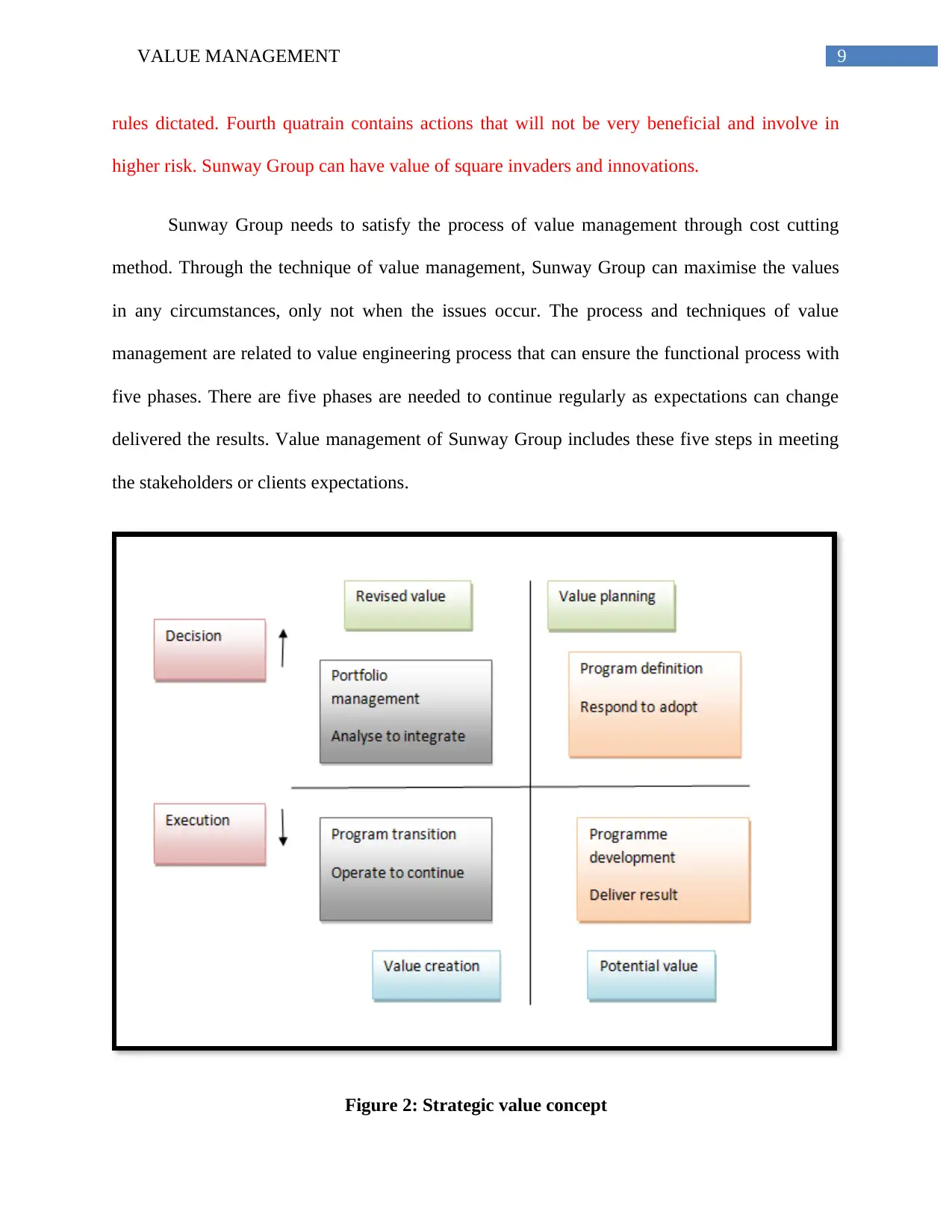
9VALUE MANAGEMENT
rules dictated. Fourth quatrain contains actions that will not be very beneficial and involve in
higher risk. Sunway Group can have value of square invaders and innovations.
Sunway Group needs to satisfy the process of value management through cost cutting
method. Through the technique of value management, Sunway Group can maximise the values
in any circumstances, only not when the issues occur. The process and techniques of value
management are related to value engineering process that can ensure the functional process with
five phases. There are five phases are needed to continue regularly as expectations can change
delivered the results. Value management of Sunway Group includes these five steps in meeting
the stakeholders or clients expectations.
Figure 2: Strategic value concept
rules dictated. Fourth quatrain contains actions that will not be very beneficial and involve in
higher risk. Sunway Group can have value of square invaders and innovations.
Sunway Group needs to satisfy the process of value management through cost cutting
method. Through the technique of value management, Sunway Group can maximise the values
in any circumstances, only not when the issues occur. The process and techniques of value
management are related to value engineering process that can ensure the functional process with
five phases. There are five phases are needed to continue regularly as expectations can change
delivered the results. Value management of Sunway Group includes these five steps in meeting
the stakeholders or clients expectations.
Figure 2: Strategic value concept
Paraphrase This Document
Need a fresh take? Get an instant paraphrase of this document with our AI Paraphraser
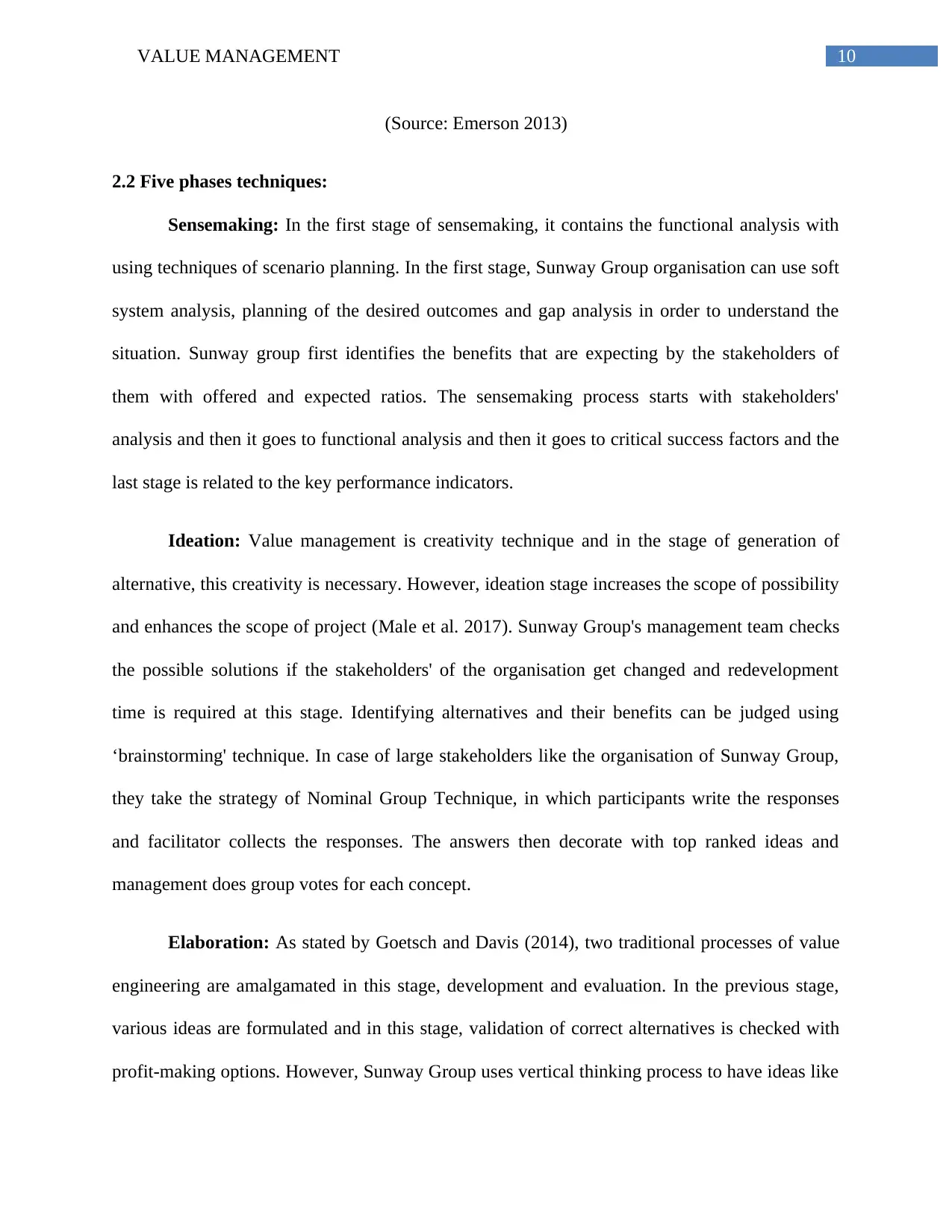
10VALUE MANAGEMENT
(Source: Emerson 2013)
2.2 Five phases techniques:
Sensemaking: In the first stage of sensemaking, it contains the functional analysis with
using techniques of scenario planning. In the first stage, Sunway Group organisation can use soft
system analysis, planning of the desired outcomes and gap analysis in order to understand the
situation. Sunway group first identifies the benefits that are expecting by the stakeholders of
them with offered and expected ratios. The sensemaking process starts with stakeholders'
analysis and then it goes to functional analysis and then it goes to critical success factors and the
last stage is related to the key performance indicators.
Ideation: Value management is creativity technique and in the stage of generation of
alternative, this creativity is necessary. However, ideation stage increases the scope of possibility
and enhances the scope of project (Male et al. 2017). Sunway Group's management team checks
the possible solutions if the stakeholders' of the organisation get changed and redevelopment
time is required at this stage. Identifying alternatives and their benefits can be judged using
‘brainstorming' technique. In case of large stakeholders like the organisation of Sunway Group,
they take the strategy of Nominal Group Technique, in which participants write the responses
and facilitator collects the responses. The answers then decorate with top ranked ideas and
management does group votes for each concept.
Elaboration: As stated by Goetsch and Davis (2014), two traditional processes of value
engineering are amalgamated in this stage, development and evaluation. In the previous stage,
various ideas are formulated and in this stage, validation of correct alternatives is checked with
profit-making options. However, Sunway Group uses vertical thinking process to have ideas like
(Source: Emerson 2013)
2.2 Five phases techniques:
Sensemaking: In the first stage of sensemaking, it contains the functional analysis with
using techniques of scenario planning. In the first stage, Sunway Group organisation can use soft
system analysis, planning of the desired outcomes and gap analysis in order to understand the
situation. Sunway group first identifies the benefits that are expecting by the stakeholders of
them with offered and expected ratios. The sensemaking process starts with stakeholders'
analysis and then it goes to functional analysis and then it goes to critical success factors and the
last stage is related to the key performance indicators.
Ideation: Value management is creativity technique and in the stage of generation of
alternative, this creativity is necessary. However, ideation stage increases the scope of possibility
and enhances the scope of project (Male et al. 2017). Sunway Group's management team checks
the possible solutions if the stakeholders' of the organisation get changed and redevelopment
time is required at this stage. Identifying alternatives and their benefits can be judged using
‘brainstorming' technique. In case of large stakeholders like the organisation of Sunway Group,
they take the strategy of Nominal Group Technique, in which participants write the responses
and facilitator collects the responses. The answers then decorate with top ranked ideas and
management does group votes for each concept.
Elaboration: As stated by Goetsch and Davis (2014), two traditional processes of value
engineering are amalgamated in this stage, development and evaluation. In the previous stage,
various ideas are formulated and in this stage, validation of correct alternatives is checked with
profit-making options. However, Sunway Group uses vertical thinking process to have ideas like
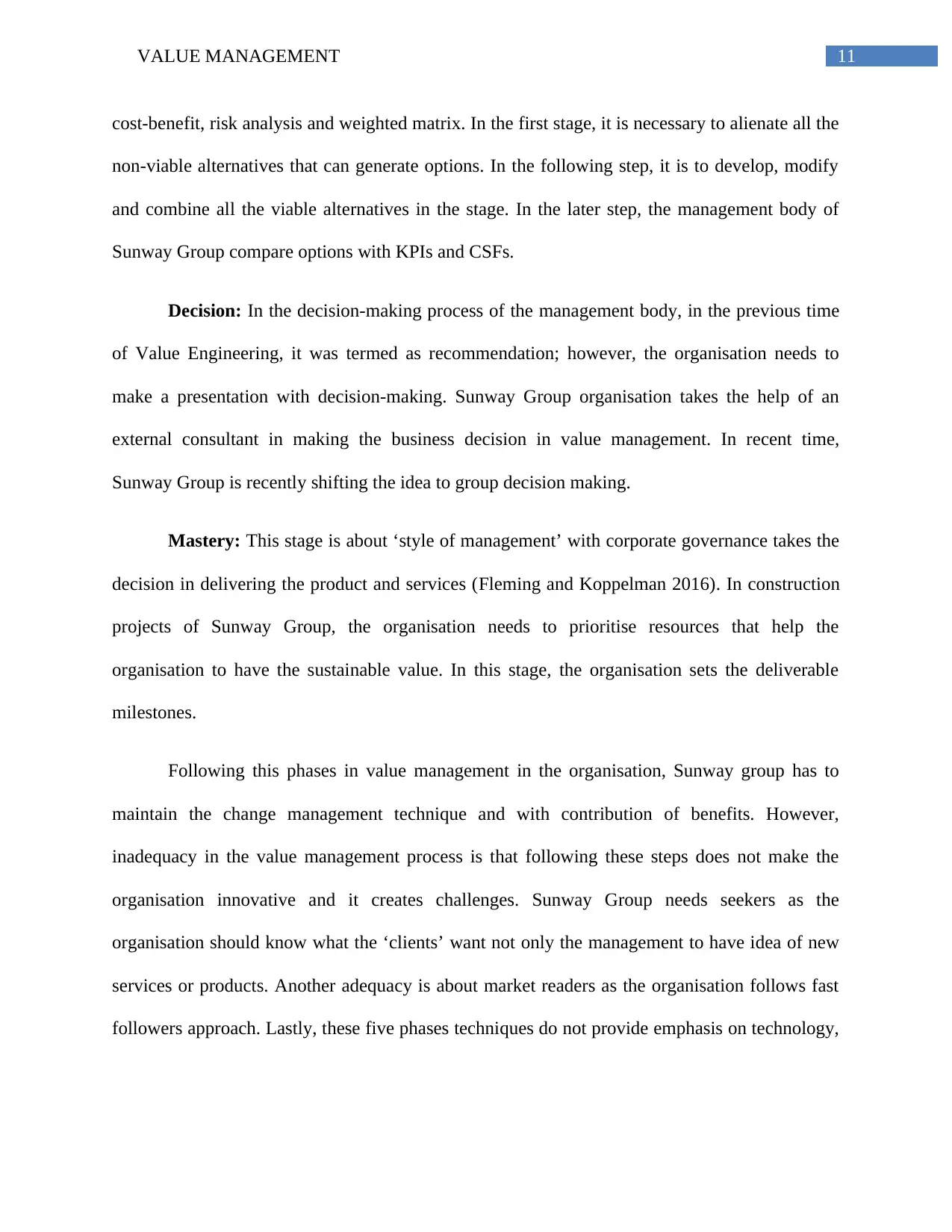
11VALUE MANAGEMENT
cost-benefit, risk analysis and weighted matrix. In the first stage, it is necessary to alienate all the
non-viable alternatives that can generate options. In the following step, it is to develop, modify
and combine all the viable alternatives in the stage. In the later step, the management body of
Sunway Group compare options with KPIs and CSFs.
Decision: In the decision-making process of the management body, in the previous time
of Value Engineering, it was termed as recommendation; however, the organisation needs to
make a presentation with decision-making. Sunway Group organisation takes the help of an
external consultant in making the business decision in value management. In recent time,
Sunway Group is recently shifting the idea to group decision making.
Mastery: This stage is about ‘style of management’ with corporate governance takes the
decision in delivering the product and services (Fleming and Koppelman 2016). In construction
projects of Sunway Group, the organisation needs to prioritise resources that help the
organisation to have the sustainable value. In this stage, the organisation sets the deliverable
milestones.
Following this phases in value management in the organisation, Sunway group has to
maintain the change management technique and with contribution of benefits. However,
inadequacy in the value management process is that following these steps does not make the
organisation innovative and it creates challenges. Sunway Group needs seekers as the
organisation should know what the ‘clients’ want not only the management to have idea of new
services or products. Another adequacy is about market readers as the organisation follows fast
followers approach. Lastly, these five phases techniques do not provide emphasis on technology,
cost-benefit, risk analysis and weighted matrix. In the first stage, it is necessary to alienate all the
non-viable alternatives that can generate options. In the following step, it is to develop, modify
and combine all the viable alternatives in the stage. In the later step, the management body of
Sunway Group compare options with KPIs and CSFs.
Decision: In the decision-making process of the management body, in the previous time
of Value Engineering, it was termed as recommendation; however, the organisation needs to
make a presentation with decision-making. Sunway Group organisation takes the help of an
external consultant in making the business decision in value management. In recent time,
Sunway Group is recently shifting the idea to group decision making.
Mastery: This stage is about ‘style of management’ with corporate governance takes the
decision in delivering the product and services (Fleming and Koppelman 2016). In construction
projects of Sunway Group, the organisation needs to prioritise resources that help the
organisation to have the sustainable value. In this stage, the organisation sets the deliverable
milestones.
Following this phases in value management in the organisation, Sunway group has to
maintain the change management technique and with contribution of benefits. However,
inadequacy in the value management process is that following these steps does not make the
organisation innovative and it creates challenges. Sunway Group needs seekers as the
organisation should know what the ‘clients’ want not only the management to have idea of new
services or products. Another adequacy is about market readers as the organisation follows fast
followers approach. Lastly, these five phases techniques do not provide emphasis on technology,
⊘ This is a preview!⊘
Do you want full access?
Subscribe today to unlock all pages.

Trusted by 1+ million students worldwide
1 out of 41
Related Documents
Your All-in-One AI-Powered Toolkit for Academic Success.
+13062052269
info@desklib.com
Available 24*7 on WhatsApp / Email
![[object Object]](/_next/static/media/star-bottom.7253800d.svg)
Unlock your academic potential
Copyright © 2020–2025 A2Z Services. All Rights Reserved. Developed and managed by ZUCOL.





